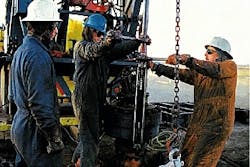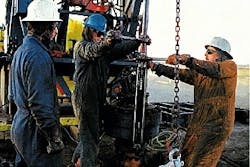Seismic surveys provide baseline for CO2 flood
In December 1999, PanCanadian Petroleum Ltd., Calgary, obtained baseline seismic measurements for a planned time-lapse (4D) seismic monitoring program of its operated large-scale Weyburn CO2-flood in Saskatchewan. - P/GSI ran its tubing-deployed, 80-level, 3C, clamped-borehole receiver array in PanCanadian's Weyburn oil field.
PanCanadian expects CO2 injection to begin in October 2000.
Paulsson Geophysical Services Inc. (P/GSI), La Habra, Calif., described the survey as including the recording of a 152,000-trace land 3D-3C vertical seismic profile (VSP), an oil field record for a 3D VSP survey.
P/GSI ran its tubing-deployed, 80-level, three-component (3C), clamped-borehole seismic receiver array with a 50-ft geophone pod spacing. This resulted in a 4,000-ft array, also a record according to P/GSI.
P/GSI says the survey provided an image of fractured carbonate reservoirs at a depth of about 5,000 ft and the deployment of a long 3C geophone array made it unnecessary to reposition a geophone tool for different surface shot locations, as often required for shorter downhole seismic tools.
It acquired the 3D-3C VSP data simultaneously with a surface 3D-3C seismic survey that used dynamite sources and Pan Canadian's patented MegaBin land acquisition technique.
P/GSI used its proprietary 3D-3C processing software to generate the first prestack depth-migrated 3D image in the field, nearly simultaneously with recording the last shot record. It delivered the final prestack depth-migrated 3D image to PanCanadian in 6 weeks after completing the survey.
P/GSI says the survey showed reservoir features, such as faults and pinchouts, on a much smaller scale than surface seismic methods and preliminary results indicate a 5-m resolution because of the high frequencies (175-200 hz) recorded.

